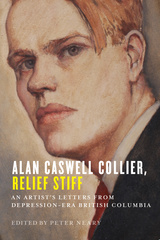
Unsettling Encounters radically re-examines Emily Carr’s achievement in representing Native life on the Northwest Coast in her painting and writing. By reconstructing a neglected body of Carr’s work that was central in shaping her vision and career, it makes possible a new assessment of her significance as a leading figure in early-twentieth-century North American modernism.
Gerta Moray vividly recreates the rapidly changing historical and social circumstances in which the artist painted and wrote. Carr lived and worked in British Columbia at a time when the growing settler population was rapidly taking over and developing the land and its resources. Moray argues that Carr’s work takes on its full significance only when it is seen as a conscious intervention in Native-settler relations. She examines the work in the context of images of Native peoples then being constructed by missionaries and anthropologists and exploited by promoters of world’s fairs and museums. Carr’s famous, highly expressive later paintings were based to a great extent on her early experiences of travel to First Nations communities. At the same time they were a response to the hopes and anxieties that attended the rapid modernization of North American culture in the 1920s and ’30s.
Moray explores Carr’s participation, with the Group of Seven, in an agenda of building a national culture and her sense of her own position as a woman artist in this masculine arena. Unsettling Encounters is the definitive study of Carr’s ‘Indian’ images, locating them within both the local context of Canadian history and the wider international currents of visual culture.
Awards
- 2007, Winner - Clio Award (British Columbia), Canadian Historical Association
Unsettling Encounters is the most unified, offering an exhaustive narrative of Carr’s engagement with painting village scenes and the arts of the totem poles from the first decade of the 20th century until the mid 1930s.
Moray…has written a fascinating and well-researched history on Canadian artist Emily Carr’s expeditions to witness and document native art in British Columbia. More than a history, Moray makes a forceful argument for Carr’s conscious attempt to represent Native art in a manner consistent with Native life and belief, in part as a critique of non-Native national and religious policies. The text is well illustrated with many period photos, the paintings of other artist, and Carr’s own drawings and watercolors…making this a splendid and full resource.
Gerta Moray’s extensive survey of Carr’s early documentary work of Native peoples is important because it discusses Carr’s attempt to record, for history and for art, Aboriginal culture and her experiences with ‘them.’ Moray underlines that Carr did so in ways that reflected the limitations of her comprehension not only of Aboriginal people but also of the sociopolitical and cultural circumstances she encountered.
Gerta Moray weaves together the complex strands of history, biography, culture, politics, government policy, ethnology, museums, and art history to tell a compelling story of Carr’s involvement with first Nations culture and art. This book is a major contribution to our understanding of Carr’s work. A landmark in Carr scholarship, Unsettling Encounters will become an indispensable resource for everyone who wants to know more about this fascinating aspect of Carr’s career.
This is an erudite, richly illustrated, and compelling narrative of how Carr related to the First Nations imagery that brought her national recognition and iconic status. Gerta Moray’s extraordinary account is sensitive to language, gender, colonial, and racial issues, reconstructing a multi-layered and well-researched context for Carr’s expeditions. Avoiding simplistic oppositions, Unsettling Encounters keeps the expressive drive and creative ambitions of Emily Carr firmly in the centre.
Bringing together a wide diversity of literature on race relations, First Nations, and art, Gerta Moray has written a thoroughly documented and superbly illustrated analysis of Emily Carr’s paintings and writings within the context of her life and contemporary social and government policies towards the First Nations of British Columbia. It is an excellent and attractive book.
Foreword / Marcia Crosby
Places Painted by Emily Carr
Part 1: Contexts for a Colonial Artist
1 The Legendary Emily Carr
2 Drawing and Insubordination
3 Missionary in Reverse
4 Among Ethnographers and Indian Agents
Part 2: A Pictorial Record of Native Villages and Totem Poles, 1899-1913
5 They Named Me Klee Wyck
6 The Despised and Joyous Way of Painting
7 Old Mythological Legends: Gitxsan Villages in 1912
8 A Great Dignity: Haida Gwaii in 1912
9 Unchanged by Fashion and Civilization: Kwakwaka’wakw Villages in 1912
10 The Largest Collection Yet Made: Carr’s 1913 Exhibition in Vancouver and Its Aftermath
Part 3: Homesick for Indian
11 Out of the Wilderness and into the National Gallery
12 What They Are Trying to Forget: Sketching Trips from 1928
13 The Big Thing That Means Canada Herself
14 Retrospect
Notes; Bibliographic; Essay; Index





